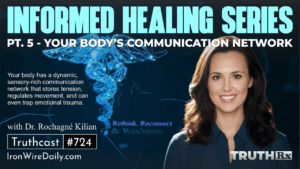Vax Injured Pilots, Is It Safe to Fly? | Greg Hill
February 23, 2023
Many of you will be aware of the multiple incidents of pilots who have collapsed in the cockpit after receiving covid vaccinations. Recently Steve Kirsch, an American entrepreneur and activist revealed on his Substack changes made by the Federal Aviation Administration on a concerning change to medical examinations for pilots, in which EKG requirements were greatly relaxed due to the large number of heart injuries.
Transport Canada has also relaxed their requirements, and if it can be believed, to an even more concerning degree.
But does this mean that flying has become unsafe? Certainly the WEF wants us to think so, as they want to restrict our movements as much as possible. But what does an experienced pilot have to say?
Greg Hill is the co-founder of FreetoFly.ca, an organization founded to fight for our right to freedom of movement. Greg is also an experienced commercial pilot who lost his job after refusing the vaccines.
In this interview, Greg talks about the changes at Transport Canada and his concerns of the impact on flight safety, but he also gives us an inside view of the redundancies built into flight crews, the training they go through in order to react quickly and decisively in the event that another pilot collapses mid-flight, and provides us with a clear and balanced view, free of fear-mongering, so that we can all make an informed decision about whether or not we feel safe to fly.
LINK:
Please share on your social media accounts
Will Dove 0:07
Some of you will be aware of multiple incidents of pilots who have collapsed in the cockpit after receiving COVID vaccinations. Recently, Steve Kirsch, an American entrepreneur and activist revealed on his Substack changes made by the Federal Aviation Administration on a concerning change to medical examinations for pilots, in which EKG requirements were greatly relaxed due to the large number of heart injuries. Transport Canada has also relaxed their requirements, and if it can be believed, to an even more concerning degree.
But does this mean that flying has become unsafe? Certainly, the WEF wants us to think so. And they want to restrict our movements as much as possible. But what does an experienced pilot have to say? Greg Hill is the co founder of FreeToFly.ca, an organization founded to fight for our right to freedom of movement. Greg is also an experienced commercial pilot who lost his job after refusing the vaccines. In this interview, Greg talks about the changes at Transport Canada, and his concerns of the impact on flight safety. But he also gives us an inside view of the redundancies built into flight crews, the training they go through in order to react quickly and decisively in the event that another pilot collapses mid flight, and provides us with a clear and balanced view, free of fearmongering so that we can all make an informed decision about whether or not we feel safe to fly.
Greg, welcome back to the show.
Greg Hill 1:43
Thanks so much for having me back.
Will Dove 1:45
Now, you’ve you’ve done this interview where you’ve agreed to do this interview with me because I received some information from you not long ago, but things that are happening with Transport Canada that are affecting the testing of the pilots. Some of our viewers might know about the information that was released by Steve Kirsch and others in the US and what the FAA is doing there. But a comment that I’ve seen from the information sent to me is that what’s happening with Transport Canada might be even worse. So would you please tell our viewers just exactly what is going on?
Greg Hill 2:15
Yeah, I’ll try not to drone on with too long of a monologue here. But it goes back to 2020. So there’s a bit of history there. And for those that haven’t seen what’s happened with the FAA, they’ve changed the standards essentially for their, what they would consider a healthy EKG, they’ve they’ve broadened it quietly, behind the scenes. And anytime that you soften safety standards for without a clear reason, there should be, there should be concern. So when I heard this, I thought, Well, man, the situation here in Canada, which is unknown to most, I would argue, is perhaps worse. And that it is.
So back in 2020, when we first started this whole COVID journey that we’re continuing on, Transport initially said, well, in rather than coming in to do an in person medical, we’ll just extend the deadlines. Like if you expire in June, we’ll kick it down the road to August or something, which, fair enough, we were all trying to figure out exactly which end was up. Once we kind of figured it out, though, what they decided to do was, well, the first year you could just to attest to your status. So you could literally get your your wife to sign off a piece of paper saying, ‘Well, Greg seems healthy.’ And that was it, then pull forward to 2021 which is where we’re still at now.
February of 23,we’re doing telemedical. So essentially, remote medicals. Now you can do two of those and then the third one has, does have to be in person. So we haven’t completely forgotten in person medicals, but you’ve got a situation now, pre COVID you’ve had to do an annual in person medical because the guidance to these Transport Canada doctors says very clearly, pilots are pretty paranoid. Essentially, it says it in in polite, you know, medical professional speak, but pilots are a little bit paranoid about their medicals and they’re not always going to be totally upfront and honest. So your job is to meet with them in person and determine their status. Some of the way we do that is with with their tools, whether it’s a stethoscope or looking in your ears or tapping on your knees or sticking an EKG to your to your chest to make sure that your heart is healthy, which is the main concern that you don’t have an issue that’s critical in-flight. Well, now we’ve got a situation where a pilot can go regardless of age up to 36 months without doing an in-person medical and that’s happening as we speak and the part of it that is so hard to wrap my head around which is a polite way of saying I’m gobsmacked,
I could I could get in an airplane right now let’s say and actually an airplane is a poor idea because the airplane is actually the air and there’s particularly clean. Let’s say I could go on a field trip with my with my kids in a you know with 30-40 them crammed on a school bus or I could I could go to a concert or a sports event or anything. That’s perfectly fine. And I absolutely welcome that and thank goodness we’re back to that to that mode. But somehow Transport is saying that I cannot as an airline pilot sit in a pristine office with a Transport Canada doctor and have my health properly assessed? Why? Like it makes no sense.
Will Dove 5:07
So are they? I’m sorry to interrupt, Greg, but are they, are they telling you that the reason why you can’t do this is because they’re concerned about transmission of a virus between you and the doctor?
Greg Hill 5:17
Yeah, well, if you look at the actual, the actual exemption, and it’s, it’s not difficult to find I’ve got copies of it here. So if you read the purpose of it, and I won’t read the whole thing, because nobody likes being read, too. But it says in part, it enable their enabling alternatives to regulatory requirements that permit social distancing. Following the declaration of a pandemic, reduce the unnecessary exposure of healthy medical certificate holder sets the pilot to potentially hazardous health care settings. Now, that purpose statement was drafted back in 2020. But it’s the same one that sits on the front of the exemption that continues to stand in 2023. And one would think, well, certainly we’re coming to the end of this right. And we’ve raised this issue with with some political offices, and their pushback is well, it’s going to end according to the transport website in March of 23. And I say, they’ve been saying that for three years, they just keep kicking this down the road.
And lo and behold, Noé Chartier with the Epoch Times, did some digging with Transport and Transport Canada spokesperson absolutely confirmed that Transport Canada intends to continue the use of telemedicine on an extended trial basis. This is an ongoing three year trial, much like flattening the curve for three years, I guess? Well, it determines how telemedicine may be integrated as a permanent feature in the aviation medical certification program. So you’ve got transport, saying they’re going to make this permanent, while concurrently their guidance to their doctors is expressing to them, why do they need to meet in person with pilots like you, it’s a complete, it’s a complete disconnect. So we’re definitely concerned.
You know, we’ve got I’ve spent hours on the phone with vaccine injured Canadian airline pilots, who I would say needs need to get themselves into a position where they can be properly assessed, and even on a good day, I’m sure you’re you’re no different than me if I have a mild ache and pain. I’m not going to run to the doctor’s office right away because it’s it’s one of the last things I feel like doing. So I’ll leave it until it becomes a crisis. And some of that’s just human nature, which is why we need to be forced to do in person annual medicals.
It’s the same reason we go in the simulator every four to six months is to make sure that we’re staying professional, that we’re staying in the books that we’re remembering how to do things in a critical environment. And these medicals in my view are the same. And it’s it’s the fact that Transport continues to accept this is an ongoing,it’s a continuation of Transport’s complete abdication under Omar Algabra abdication of their responsibility as the regulator for safe transport in this country, in my view.
Will Dove 7:57
So I want to sum up a few things here, Greg, because just to make sure that I’m following what you’re telling me. So first, prior to 2020, pilots were required to see their doctor once every year for a full medical in person. Yeah, 2020 they suspended that and said, Well, you can just you can get a test station as what you call that. Basically, you can get somebody who knows. You said Yeah, well, they seem fine to me. And then the last two years now 2021 2022, they can talk to their doctor, you know, like we’re talking right now via zoom, I assume or over the phone or whatever. And the doctors gonna ask a few questions. There’s no actual physical assessment done —
Greg Hill 8:37
— except for the third one, except for the third one.
Will Dove 8:41
But they’re saying so ( want to make clear it. So what they’re saying now is they want to make this telemedicine thing permanent, which would mean that moving forward pilots only have to get a full in-person medical every three years?
Greg Hill 8:55
Well, how exactly that frames out? I’m not completely sure. Right. I mean, it was it was a good spokesperson statement in the sense that you can’t drill down to the very bottom of it, they’re saying they’re going to determine how it factors into a permanent feature. So whether that’s a you know, you can only do one telemedical I don’t have those – I don’t have answers to those questions, but it sounds like contrary to what’s on their website, which is you know, this is going to wind down in March that you know, this is no different than what’s what’s happening elsewhere where you pick it arbitrary date, whether it’s a TSA directive or otherwise, and you you wait for that date to come and then lo and behold, surprise, surprise it gets kicked down the road, two or three months. And it sounds like that’s what transport intends to do with this as well.
Will Dove 9:42
So what are your – you’re a pilot, you don’t engage in hyperbole and fear mongering. But obviously we should be concerned about this. And as an experienced pilot, what are your concerns?
Greg Hill 9:55
Yeah, well, I appreciate the quiet the question, because I think we’ve worked really hard
as Free to Fly to you know, I sort of laugh about it but but the Sully Sullenberger archetype, right? The landing on the Hudson, where you lose both engines and you you have to land your aircraft the last thing you want is the pilot to be screaming and pushing buttons without thinking about it. So we want to give a nuanced answer to a question like that as well. So my nuanced answer is yes, there’s elevated risk. I like to use the analogy of a snowstorm, right? So you need to get milk and bread and you’re planning to go see your friends for dinner, you’re still going to go, you’re not going to cease moving about the countryside because there’s snow. Once you put snow tires on, you drive a little bit slower.
And I would say aviation is similar in that sense. And what needs to be happening is Transport Canada needs to put the snow tires on, they need to get pilots back in person doing in-person medicals, to mitigate some of this risk. Now, from a day to day standpoint, we do have people emailing us and saying, My goodness, should I stop flying ever again? And my answer to that? The short answer is No. I’ll give you a longer answer because there has been some fear mongering, as you alluded to, over the past several weeks with what we’re seeing coming out of the States. And that frustrates me. Because we’re seeing names or we’re hearing comments about airplanes plummeting out of the sky and tripping, you know, flying into apartment buildings, so many 911 imagery and otherwise. And that’s just anybody who’s who’s an aviator knows, that’s not what happens when it – when a pilot gets incapacitated.
If I’m flying from point A to point B and the guy flying with, I don’t know has food poisoning or a heart attack. We react as we’re trained to, and we’ve trained for this for decades that I’ve been in aviation. We ensure the control of the aircraft, we make sure we’re going the right way, that we’re maintaining altitude, to take control of by our hand flying but the vast majority of the time, we’re on autopilot and continues trucking towards Vancouver. But at that point, things get very busy, the risk is elevated, because now I’m essentially single pilot.
So I want to secure the guy that’s had the issue, I want to get a seat back, get it locked, if we can get him out of the seat, if there’s a guy that’s, that’s, you know, another pilot that’s flying along, get him up there too, to at the very least help me work the radios and otherwise, but then I’ve got to get to talk to air traffic control, I got to figure out okay, I’m gonna divert to Regina to get this guy some hospital care as soon as possible. So you know, you’re going to descend, you’re going to plan the approach, you’re going to brief the passengers, the flight attendants, the company, etc. So it becomes a very busy scenario. It’s one that we train for, but the risk is definitely elevated. The planes don’t fall out of the sky, when one of their two pilots become incapacitated. Now, having said that, phases of flight increased risks. Takeoff and landings obviously, are high risk scenarios. So if you’re, you know, below 100 feet on a takeoff or landing and you have an issue, it’s, it’s a different scenario. But you know, those are things that we we certainly think about and think, Okay, if, if this happens on a takeoff, what do you do or otherwise?
So, to answer your question short, it’s, it’s a higher risk scenario right now. But it’s one where we could be dealing with it properly, if Transport Canada would do their job, and start to actually create an environment, I would say where guys that are dealing with post vax issues, feel a permissive environment where they can raise their hand and say, I got an issue and I need it looked at, and I need treatment, but I don’t really want to, you know, lose my job. Because they took the job, some of them, to save their job. And now they’re in this terrible situation where in order to keep their job, there’s pressure for them not to point out the issues that they’re having. Some of them are minor, but some of them are not. And they run the full gamut of everything that we’re seeing in society right now over and over again.
Will Dove 13:47
Greg, you and I both know that the WEF wants to destroy commercial air travel, they want to shut it down, stop us all from moving around. So I think something we could do right now that would be very productive for the viewers, is to walk them through this scenario of as you said, You’ve trained for this. So let’s, let’s say you’re the co pilot, the pilot has just collapsed. I’m going to ask him the question. So I’m pretty sure but going through the minds of our viewers, so that hopefully you can lay fears to rest. So the first question that would occur to me is, is there any point during a flight where two pilots are required to safely operate the plane?
Greg Hill 14:25
Well, one pilot is always in control of the aircraft. So like, even if I get up and have to use the facilities, I say “You have control.” I tell the guy you know, “…here’s where we’re going, here’s the airspeed we’re at you have control. “So he’s the only guy whose hands are either figuratively or physically on the controls at that given point of time. And we typically fly leg to leg so I’ll fly “leg” one then the first officer flies leg two and we go back and forth. So you’re never in a scenario where both guys – it would bem it would be really bad if both guys had their hands on the controls at the same time.
Which is why we make it clear who has the control. So the other guy is essentially working the radios monitoring parameters, doing paperwork related to the flight and otherwise. And that’s how we that’s how we split up the duties. So you need both pilots for the reason that I just mentioned, like if one guy gets incapacitated, you’re, you come very close to reaching what we call task saturation, where things start to drop off, where because you, you want to make sure that you’re prioritizing and hitting the high points at navigating, communicating, right? Keeping the blue side up, making sure you’re going in the right direction, and then talking to air traffic control or whoever else you need to talk to. So that’s how a typical flight works in terms of who’s actually controlling the aircraft.
Will Dove 15:44
Rght, so you’ve answered my question. What I was getting at is because of course, I’m not a pilot, our viewers, by and large are not pilots? It’s a great question. Yeah. What are some of those works? So what you’ve just told me is no, there is no period from takeoff, through flight, to landing, where you have to have two pilots in the cockpit at the same time in order to safely operate the plane. All of these things are where there’s there might be two pilots in the cockpit, but only one of you is controlling it.
Greg Hill 16:13
Yeah, only only one has his hands on the controls. When you, when you ask this question, unfortunately, what comes to my mind is the fact that we’ve got people now that are trying to push us down the road of having single pilot airliners, and I don’t want to feed anything into that, because what I’m saying is you always want to keep your task levels to a manageable point. And if you’re trying to do everything to pilot an aircraft, you’re going to reach task saturation, and there’s things that are going to fall by the wayside, and eventually, something’s going to fall by the wayside. That’s critical. I’m not saying critical that the aircraft is going to crash. But you may miss a radio call. If you’re on the ground, you may taxi down a wrong taxiway or otherwise, right. I mean, the big picture stuff, we’re professional pilots, and we’re very good at prioritizing.
So in terms of flying an approach, maintaining a safe airspeed, intercepting the localizer on an ILS approach, those type of things or big ticket items that guys don’t, don’t miss because we train and train and train for them. But we I mean, we need to there’s there’s two pilots there for a reason one’s not extraneous. He’s there to maintain that saturation level at an acceptable point, but only one guy is flying the aircraft, so you can safely get the aircraft on the ground with with one pilot, it’s just not ideal.
Will Dove 17:30
Right? Okay, thank you. So that’s what I was looking for there. So now let’s talk about the next scenario, I think would occur to our viewers, because we see this in movies, where you get a pilot to collapse his face first onto the control board. Okay, that happens, the guy beside you has a heart attack, and he pitches forward. Is he going to hit something when he collapses? That could potentially cause a serious problem?
Greg Hill 17:54
Well, I mean, I could get into all sorts of nuance. I mean, if it’s, if it’s a side stick aircraft, like an Airbus, there isn’t a yoke there to fall forward on. So it’s, you know, it’s sort of funny, but it’s the it’s honestly the truth. It depends on if you’re on a Boeing or an Airbus, and I don’t want people buying their tickets based on on whether you’re on a Boeing or an Airbus necessarily, but some of these aircraft have side sticks. So they’re not really in the way, most of the Boeings have our sticks in front of them. So theoretically, yes, there’s nothing you could fall forward onto.
But, I mean, if you if you tried to find the absolute worst case scenario, in that you’re 20 feet off the deck, doing an approach and a guy collapses forward, then yes, I mean, that’s, that’s probably the worst case scenario. But even if you’re in cruise, and you were to fall forward on a control yoke, you might feel a bump, but it’s actually it’s essentially locked in position through the autopilot. And the brief time that the guy would fall forward, let’s say you lose 100 or 200 feet, you’re going to get him back, you’re going to call for help and lock his shoulder harnesses and, and that’s the part I was telling you about where the first thing I’m going to do is, I don’t care about talking to anybody, I’m just going to make sure that the aircraft maintains altitude, take control, lock his seat harness, move his seat back, get them out of the way, get them out of the seat, get a medical care in the back, etc.
But there are worst case scenarios. But I like to use the analogy that I mean, if this is our level of concern, then we should all be having conversations that are far more prevalent, perhaps about people moving up and down the highway, because all these people are, you know, 84% of them are vaccinated doing 120 down the highway in Toronto across six lanes. single pilot in their cars, right. So so these are some things that that should be of equal concern. So again, I don’t want to downplay it and say there’s no risk, there is risk and it’s why I’m sitting here talking to you and I’ve been talking to others about these things. But we want to take a measured approach to it.
And then even pre COVID people like, oh, you know, that’s a dangerous job you’ve got, I’m like, now you’re gonna pray for me pray for me on my two hour drive to Toronto, right? Because that’s the part where I’ve become very close multiple times of being aced by a tractor trailer, way more often than I’ve ever had, you know, I haven’t had any issues from the flying perspective, right.
So you know, CS Lewis has a great quote about risk. And I will, I won’t sit here read it to you, but it’s one of my favorites ever. And it essentially says, Let’s enjoy the things of life, like it’s back from 1948, talking about nuclear war, essentially saying, if a bomb is going to get us, let us let it find us doing things that matter, right? Playing darts with friends and having a pint and looking after my children and otherwise. So I think we’ve got to take a measured approach here as well. And that’s what we ultimately want to do is put the put Transports’ feet to the fire and get them doing their job, because because really, that’s one of the best ways we can mitigate this risk is in ensuring proper medical oversight.
Will Dove 21:00
Right. And I so but I do want to get back just a little bit to what we were discussing. So yes, you were very honest. Sure, there’s that extremely unlikely worst case scenarios, you said, you’re 20 feet off the deck, you’re landing and the guy collapses, that could pose a problem. But I think everybody understands, it’s extremely unlikely that a the collapse is going to happen in the first place and B, that’s going to happen at that particular point in time. So you’ve got the you’ve select, say, you’re in the air, the other pilot has collapsed. And you’ve had to go through that procedure that you’ve been trained to do to regain control of the aircraft. Roughly how long does it take for that procedure until you have secured control, and now you’re now over in control of the aircraft again?
Greg Hill 21:45
Well, I mean, realistically, if I’m if I’m in cruise on my way to Vancouver, it’s a matter of seconds, it’d be because the aircraft is on autopilot. trucking along anyway. So if he, you know, typically, when we train for this sort of stuff in scenarios, they create an environment where I need to ask Joe something, right, and Joe doesn’t answer me. And then I’m like, Joe, Joe. And then Joe kind of slumps over and, you know, then you locking his harness and going through everything that I mentioned to you. But in terms of securing control, you know, I’m going to have to change some automation settings to ensure that now I’m the guy that’s technically in control of the aircraft at this point.
But it’s a matter of, it’s a matter of seconds, in terms of securing the whole thing to the point where we get them on the ground, obviously. You’re talking half an hour type thing, or if you’re across the ocean, worst case, now you’re talking a much longer period of time where you’re going to have to go to a diversion field in Greenland, Greenland, or something like that. Just depends on where, where exactly you’re at. But a lot of those oceanic flights, now you’re talking three, four pilots are on board, as well, in the long haul type thing as well, which, which brings up a good point.
I really appreciate this conversation, because it’s, you bring up questions that don’t necessarily pop into my mind, because I’ve been doing this flying thing for 30 years. And I just, it’s like water to me, right? I just swim in it. But those questions, so that’s another good point. If you’re going to, you’re going to Australia, you’ve got four pilots, you know, they’re the guys that are sweeping on Route, because you can’t just sit there for 14 hours and truck along with with just two guys in the seats. So right.
Will Dove 23:21
So this this, give people that information as well, because I didn’t know that. And I’m sure a lot of our viewers didn’t know that. Because I’ve always assumed that just about any flight, you’ve got two pilots, but you’ve just told me that there’s longer flights where you’ve got three, four pilots. So what’s, is there a cut off on terms of distance?
Greg Hill 23:25
Not distance, it’s time and I was afraid you’re gonna ask me that, because I’m not a long haul guy. So I actually, I, I was previously talking to you about saturation levels, and my brain works on the max capacity level. So if there’s things that I can offload that I don’t need to know, and one of them is, when do we need a third pilot because I’m a what we call a narrow body guy. I’ve chosen to do the Canada US Caribbean thing because I have no interest in sitting in a metal tube for for quite that long. But, so I can’t off the top of my head. I couldn’t tell you what the, what the hourly is somewhere in the nature of eight to, eight to 12 hours somewhere in that ballpark. Reatta a third and then eventually a fourth, fourth guy on board Matt, my co director he’d be able to tell you because he knows that stuff. By nature of where he’s working, which is he’s the overseas type stuff.
Will Dove 24:23
Okay, but for now, I think we’re safe telling people that if it’s a domestic flight, since the Air Canada US flight, there’s probably two pilots, but if it’s longer than that, if you’re flying across the ocean, there’s almost certainly at least a third pilot onboard.
Greg Hill 24:38
Yeah, unless you’re going to maybe the UK out of the east coast or something like that. So yeah, right.
Will Dove 24:42
Okay. Well, that’s I think that’s very reassuring for people because we talked earlier before the interview about the unlikely possibility that both pilots collapse and you compare that to the extremely unlikely eventuality of both engines going out. So I think that I hope that that’s going to put people’s fears to rest, to realize that there are backups in place but however, you did say something a while back that set off alarm bells for me something about a move towards single pilot flights?
Greg Hill 24:48
Yeah, I mean, this is I would say it’s in line with our strange human obsession with at least in certain sectors of society of offloading horrible things like work. So we can all sit around and do nothing, which people somehow think is going to be a utopia. And it’s like, no, we were created to work for a very good reason. And so part of that, you know, whether it’s through AI or otherwise is talk of moving to single pilot aircraft. So I’ve seen some of it on social media, just given the nature of other things that I’m focusing on right now, I haven’t done done a deep dive into it. But this isn’t brand new. It’s not something that just popped up over the last six months, or even last year or two, it’s been talked about in corners over the past, I would say probably five plus years. But it’s becoming more prevalent along with other sectors that are talking about driverless trucks and other things right. And, and this is not good that the idea that people are just going to sit at home and take government handouts and somehow be fulfilled and healthy is an absolute fallacy.
Will Dove 26:19
Indeed, it is. So just to clarify, as far as you know, these are things you’ve read about on social media, but you we don’t have the FAA or Transport Canada, at this point in time having put forth any proposals to move to single pilot flights.
Greg Hill 26:35
Not Transport. FAA, I couldn’t tell you for sure. Whether they’ve put up paperwork on it. I’d have to go offline here afterwards and do a deeper dive. But I appreciate the question. Like I said, it’s, as we talked about offline before, there’s only so many hours in a day. And that one I haven’t done, I haven’t done a deep dive into so.
Will Dove 26:53
Okay, thank you, Greg, I really appreciate you coming in providing us with this accurate information, this insightful picture because as I said I’m not a pilot, our viewers aren’t pilots, you’ve just done a great deal to reassure me that even despite the injuries from these jabs and the potential for a pilot to collapse, it’s extremely unlikely that the plane is going to fall out of the sky as a result. I mean, could it happen? Yes, it could happen. But it sounds to me like we’re talking about lightning striking. Pretty darn close —
Greg Hill 27:21
— yeah, well, and we’ve a lot of us have done more work in the in the calculator zone, right, even back to 2020, trying to determine things like IFR and CFR and otherwise. And so we’re talking fractions of a percentage. So I don’t want I don’t want to go the other extreme to say, well, you don’t there’s there’s nothing to worry about it and we shouldn’t be having this conversation, because we absolutely should. And I hope that I’ve laid out the elevated risk scenario effectively so that people understand, we have absolutely got to push the airlines, the unions, Transport Canada and others to start focusing on the reality of vaccine injury amongst pilots.
The elevation of risk is, you know, I realized after I said to you, Will, you know, it’s like the odds of losing both engines. And then I summon Chesley ‘Sully’ Sullenberger and his dual engine failure out of LaGuardia. Right, so it does happen. I mean, he handled it phenomenally well. So we’re talking, you know, fractions of a percentage of increased risk. But hey, that’s why the government has done absolutely insane things to the globe because of slightly elevated fractions of risk over this past several years. So I would ask, maybe you should also be focusing on this for exactly the same reasons because that risk is elevated, whether we like it or not.
Will Dove 28:38
Right. And I think you’ve done a very good job of giving people balanced information, certainly, we should be concerned about the relaxation of these medical tests. And I, folks, I would strongly advise you go to free to fly.ca and sign up on their newsletter, get involved here as you can to push back against this because these pilots need to be tested, I think, probably Greg would agree with me, and that knowing that we’ve got these vaccine injuries out there, not only should we be doing in person tests once a year, I think maybe we should certainly be doing them every six months, rather than stretching it out. And let’s, let’s just make sure that we find out because, of course, you can’t blame a pilot who’s trying to make his living have, you know, maybe he notices a couple of odd things. But the last thing he wants to do is to get grounded and lose his job. So if they’re required to go in and have these medical tests done, then we can catch those things before these people encounter serious medical issues on a plane. But at the same time, you’ve also painted for us a picture of what’s really happening in the cockpit of pilots situation on flights and the extreme likelihood that you’re going to have two pilots collapse on the same flight. So I think you’ve done a very good job of giving people that Balanced View. Do you have any final words for our viewers?
Greg Hill 29:52
The only thing I’d say is the unions I think as well. We need to be stepping up like of all people they should be behind the scenes creating a permissive environment. for these guys to at least talk to the Union about some of the issues and there doesn’t even seem to be a curiosity or even a willingness to, to engage. So I guess I’ll take the opportunity with that last comment to give them a poke because we’ve been poking them in written communication and we’re getting nothing from them. So, but anyway, I appreciate the platform. Will. You ask fantastic questions and keep up, keep up the great work.
Will Dove 30:21
Thank you very much, Greg.
Greg Hill 30:22
My pleasure.
Transcribed by https://otter.ai
314 Greg Hill interview_otter_ai
Want Your Country Back?
We are in desperate need of monthly recurring donations so we can hire assistants to create more tools in a timely manner. Donate below!
Can You Donate Monthly?
Please consider making your donation monthly. This allows us to make commitments to produce tools and content we otherwise cannot.









